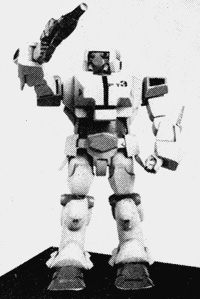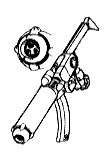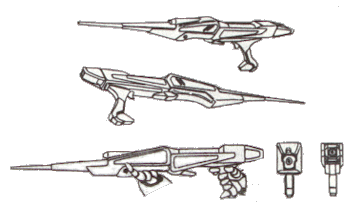

Designation:MBR-21 Basilisk Tactical Corps Desert Division Main Battle Robot |

|
||||

|
|||||
| Mk. I | Mk. II | Total Height: | 6.1 m | 6.1 m |
|---|---|---|
| Total Depth: | 2.7 m | 2.5 m |
| Total Breadth: | 2.8 m | 2.8 m |
| Weight: | 15.2 | 16.1 metric tons |
MBR-21C Models

Common optional hand-held gun pods:
|

|

|

|
The armor on the unnamed is a new development in low-mass composite-materials Chobham plating that became the standard for all Terran mecha after its application to the VQ-6A Vandal. Aside from the respectable protection provided against projectiles, missiles, and other kinetic weapons, this armor is also resistant to plasma globes (annihilation discs), lasers, and to a lesser extent, particle guns, owing to the fact that the armor can flake off and evaporate in layers under fire from such high-energy weapons, taking much of the weapon's energy and converting it into the latent heat of sublimation in the armor. The armor stops all small arms, heavy infantry weapons fire, and light mecha-mounted weaponry, such as the Zentraedi 22.3mm HE autocannon round, and fair to good resistance (Mk. I) or good resistance (Mk. II) to medium mecha-mounted weaponry, such as the Valkyrie's 55mm APFSDS round. The arm shields provide good resistance to medium mecha-mounted weapons and poor resistance to heavy mecha-mounted weaponry, such as the VHT-2's 120mm shell.
The Basilisk provides full protection from nuclear, biological, and chemical hazards, using a fully sealed cockpit module activated by radiation and hazardous chemical sensors, or manually when biological warfare conditions are anticipated. The module is also armored and gives the Basilisk the option of operating off-planet on the moon or elsewhere in the system. The internal consumables supplies can provide atmosphere purification for one week maximum on Earth and 48 hours in a hostile environment such as the moon or Mars. The MBR(S) models double the consumables supply to last for 96 hours in a hostile environment.
In 2027 the Eastern Bloc Soviet Independent States, in coalition with their south west Asian satellite states began to expand into the oil rich territories of the northern Saudi peninsula. The campaign was well over before the ASC had a chance to react. Afterwards the Soviets placated their Arab allies by undertaking the “liberation” of Palestine. Israel was not an actual member of the UEG, having maintained their independence since the end of the 1st Robotech War. While the Israeli Defense Force was able hold the line at the West Bank, it was unlikely that they would be able to hold out for long with out reinforcement from the ASC or nuclearization of the battlefield. They chose to accept the help of the Southern Cross. However, the price was their independence.
After the shooting was over, the ASC Tactical Corps was able to assess the effectiveness of its equipment in combat. Among many of it’s weapon systems, the MBR-13 Salamander was found wanting. Sand and grit worked their way into the Salamander’s leg and torso actuators, servos wore out and the cooling system for the electronics suit was inadequate. In combat, the Salamander suffered heavy loses against Soviet tanks. 145mm APFSDS rounds tended to have little trouble zipping through the frontal armor while ATGMs and even RPGs were able to defeat the lighter armor on the back. What was worse, none of the EU series gun pods could reliably penetrate the frontal armor on the T-17, the most common (and oldest) tank in the theatre. The ASC decided it was time for a new main battle robot.
Bofors, Israeli Military Industries and Urdan Industries Ltd. (also of Israel) went to work on a new battloid. The new battloid was based on the same basic chassis as the Salamander, but with enough changes to justify a new designation. Heavier armor was added front and rear, as well as to the arm shields. The resulting increase in weight necessitated up-rated locomotive actuators, which in turn required additional power. The latest generation of Protoculture Energizer, and an increase of two extra cells met the increased demand. The new mecha, by that time designated the MBR-21, was slightly slower than the old Salamander but had increased hop range thanks to improved jump jets. The frontal armor still could not defeat the latest generation of APFSDS rounds, but the arms could.
A whole new sensor suit was designed, using the Westinghouse’s latest 360 degree battlefield radar system. This radar could detect incoming missiles (esp. ATGMs) and main gun rounds and was networked to the head lasers and arms. When an incoming missile was detected, the EL-8s would automatically engage to shoot them down before they could reach their target. The arms would automatically shield the main body from main gun rounds. Israel’s own Electro-Optics Industries Ltd. Provided the rest of the fire control system.
An MM-24 missile launcher was built into the chest to address the Salamanders lack of offensive punch. The clam shell armored doors concealed 24 Hammerhead short range multi purpose missiles. The Hammerhead significantly boosted the Basilisk’s punch relative to the Salamander. It could now engage tanks, enemy mecha and aircraft at ranges fare greater than that of its gun pods. Later a new version, the mk. II, replaced the Hammerheads with a MIM-60 missile launcher in the chest, containing 60 Viper missiles. Though they had shorter range and could only attack ground targets, they were much smaller allowing the MBR-21 mk. II to carry more than twice as many and mount heavier frontal armor. The mk. II was more of a supplement to the mk. I, rather than a replacement. Both missiles types provided an indirect fire capability to the Basilisk, allowing it to attack tanks in the defilade or hiding behind sand berms or concrete structures. A top attack profile enabled the missiles HEAT warhead to penetrate the weaker top turret armor of enemy tanks. This ended the dependence on close air support and artillery assets for taking out dug-in opponents.
During the Soviet incursion, Russian and Arab gunners had little trouble identifying and picking off officers and NCOs by their unique head designs. This was addressed in the Basilisk. Both the standard and the Command ( C ) models had identical looking heads. The MBR-21C did incorporate improved sensors and C3I systems. Cooling was improved and seals for the hydraulic systems were made more rugged to help the Basilisk deal with harsh desert conditions.
Development and testing progressed quickly, and the first units to receive the new battloid took delivery in August of 2029. Tactical Corps Desert Divisions and newly absorbed units from the IDF had first priority and by the end of 3032 all of the units in deployed to South West Asia had turned in their Salamanders in exchange for the MBR-21 Basilisk. In 2032 the Tactical Corps units stationed in Central Europe began to transition to the MBR-21 as well. A space optimized version, the MBR(S)-21 mk. III was planned and tested for ASC TC Lunar Divisions, but never made it to production thanks to the events of 2033.
Today, a relatively large number of Basilisks survive. Few were lost in the 2nd Robotech War, thanks to the fact that the Middle East was not very high on the Robotech Masters’ list of priorities. The Invid also largely ignored the region when they arrived a few years later. The hundred or so surviving Basilisks went on to serve in the post war, independent, IDF.
See additional design notes.
Return to Southern Cross Mecha Index.
Go to Robotech Reference Guide Home Page.
Robotech (R) is the property of Harmony Gold. This document is in no way intended to infringe upon their rights.
Content by Rob Morgenstern, and Tim Wing with Pieter Thomassen, and Peter Walker